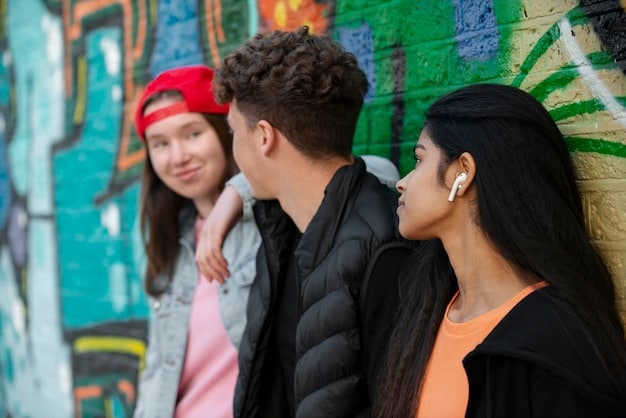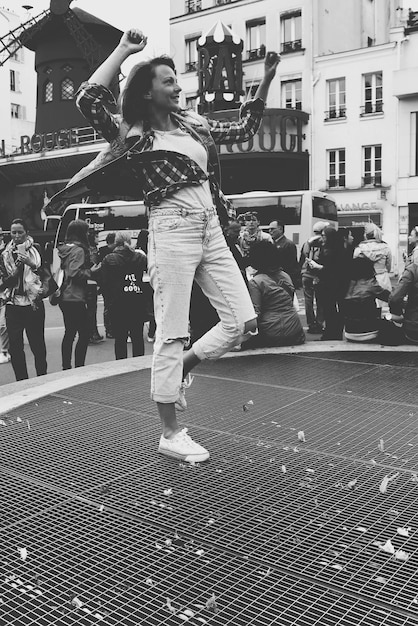Sneaker Culture in Germany: Trends, Classics, and Evolution

Advertisements
The evolution of sneaker culture in Germany reflects a journey from functional footwear to a symbol of personal expression, deeply influenced by global trends and adapted to local tastes and historical contexts.
The story of sneakers in Germany is more than just a tale of footwear; it’s a cultural phenomenon that mirrors the nation’s social, economic, and artistic developments. Join us as we explore the evolution of sneaker culture in Germany: from trends to timeless classics, uncovering the key moments and influential figures that have shaped this vibrant scene.
Advertisements
The Early Days: Functionality and Sport
In the early 20th century, sneakers were primarily designed for athletic activities. German brands played a pivotal role in the early development of sports shoes, focusing on functionality and performance.
The initial focus was on creating shoes that provided athletes with the necessary support and grip for various sports, setting the stage for the sneaker revolution.
Advertisements
Pioneering German Brands
Several German brands emerged as pioneers in the athletic footwear industry, contributing significantly to the innovation and design of early sneakers.
- Adidas: Founded by Adolf “Adi” Dassler, Adidas revolutionized sports footwear with innovations like the three stripes and specialized shoe designs for different sports.
- Puma: Founded by Rudolf Dassler, Adi’s brother, Puma quickly became a competitor, focusing on performance-enhancing designs and endorsements from famous athletes.
- Hummel: While Danish in origin, Hummel gained popularity in Germany, known for its distinctive chevron pattern and focus on team sports.
These brands not only provided athletes with the tools they needed to perform but also laid the foundation for the cultural phenomenon that sneakers would become.
The early days of sneaker culture in Germany were marked by a practical approach, with functionality taking precedence over fashion. However, the seeds of a future cultural revolution were being sown.
The Influence of American Culture
The post-World War II era brought significant cultural exchange between the United States and Germany, profoundly impacting fashion, music, and, of course, sneaker culture.
American trends, particularly those from the realms of sports and hip-hop, began to permeate German society, influencing the styles and preferences of the younger generation.

Hip-Hop and Basketball
The rise of hip-hop and basketball in the United States had a ripple effect across the Atlantic, with German youth embracing these cultures and adopting their iconic footwear.
- Adidas Superstar: Popularized by hip-hop group Run-DMC, the Adidas Superstar became a symbol of street style and cultural rebellion.
- Nike Air Jordan: Michael Jordan’s signature shoes transcended the basketball court, becoming a coveted item among sneaker enthusiasts in Germany.
- Converse Chuck Taylor All-Stars: These classic sneakers gained traction as a versatile and timeless option, favored by various subcultures.
These sneakers were not just pieces of footwear; they were symbols of cultural identity and belonging, connecting German youth to the broader global landscape of sports and music.
The influx of American culture into Germany during this period played a crucial role in shaping the sneaker landscape and setting the stage for the emergence of a distinct German sneaker identity.
The Rise of Sneaker Collecting
As sneakers gained popularity, a subculture of collecting emerged, driven by enthusiasts who sought out rare, limited-edition, and historically significant models.
Sneaker collecting became a serious hobby, with individuals investing significant time and resources into building their collections and connecting with fellow aficionados.
The Hunt for Rarities
The thrill of the hunt and the allure of owning unique and hard-to-find sneakers fueled the growth of the collecting community.
Collectors scoured vintage stores, online forums, and international markets in search of coveted models, often paying premium prices for these prized possessions.

The value of certain sneakers skyrocketed, transforming them into investment pieces and status symbols within the collecting world.
The rise of sneaker collecting in Germany underscored the cultural significance of these shoes, elevating them from mere footwear to objects of art and historical importance.
German Sneaker Boutiques and Retailers
The growing demand for sneakers led to the emergence of specialized boutiques and retailers catering specifically to the needs of sneaker enthusiasts.
These stores curated a selection of both mainstream and niche brands, providing a platform for emerging designers and collaborations.
Showcasing Global and Local Brands
German sneaker boutiques played a crucial role in introducing international brands to the local market while also supporting the development of German sneaker brands.
- Solebox: Known for its exclusive collaborations and limited-edition releases, Solebox became a destination for sneaker collectors in Germany.
- Overkill: This Berlin-based store gained a reputation for its curated selection of sneakers and streetwear, attracting a loyal following.
- Afew Store: Located in Düsseldorf, Afew Store stood out with its community-focused approach and unique sneaker offerings.
These boutiques often hosted events, release parties, and art exhibitions, creating a vibrant community hub for sneaker enthusiasts.
The presence of these specialized retailers solidified Germany’s position as a significant player in the global sneaker market, fostering innovation and creativity within the industry.
Collaborations and Limited Editions
Collaborations between sneaker brands, designers, artists, and retailers have become a defining aspect of sneaker culture, driving hype and creating highly sought-after limited-edition releases.
German brands and creatives have actively participated in these collaborations, contributing to the global sneaker narrative and showcasing their unique perspectives.
German Contributions to the Sneaker World
These collaborations brought fresh designs, innovative materials, and unique storytelling to the world of sneakers, further blurring the lines between fashion, art, and sport.
German retailers often teamed up with major brands to create exclusive colorways and designs, celebrating local culture and heritage.
Artists and designers used sneakers as a canvas for their creativity, producing limited-edition works that reflected their individual styles and philosophies.
These collaborations not only boosted the profile of German sneaker culture but also helped to elevate the industry as a whole, fostering a spirit of innovation and creativity.
Sustainability and the Future of Sneaker Culture in Germany
As awareness of environmental issues grows, sustainability has become a major focus within the sneaker industry, with brands exploring eco-friendly materials and production methods.
German consumers are increasingly demanding sustainable options, driving brands to innovate and adopt more responsible practices.
Eco-Conscious Sneaker Initiatives
German brands and retailers are at the forefront of the sustainability movement, implementing various initiatives to reduce their environmental impact.
- Adidas x Parley: This collaboration utilizes recycled ocean plastic to create innovative and environmentally friendly sneakers.
- Veja: While a French brand, Veja has gained popularity in Germany for its commitment to using organic cotton, wild rubber, and recycled materials.
These initiatives are not only appealing to eco-conscious consumers but also setting new standards for the industry, inspiring other brands to follow suit.
The future of sneaker culture in Germany hinges on the industry’s ability to embrace sustainability and create products that are both stylish and environmentally responsible.
| Key Point | Brief Description |
|---|---|
| 👟 Early Functionality | Focused on athletic performance, paving the way for Adidas and Puma. |
| 🎤 American Influence | Hip-hop and basketball trends popularized sneakers like Adidas Superstar and Nike Air Jordan. |
| 💰 Rise of Collecting | Enthusiasts seek rare models, transforming sneakers into investment pieces. |
| ♻️ Sustainability | Growing demand for eco-friendly materials and responsible production methods. |
Frequently Asked Questions
▼
Adidas and Puma, founded by the Dassler brothers, were pioneers in athletic footwear. Adidas is known for innovations like the three stripes, while Puma focused on performance-enhancing designs.
▼
The rise of hip-hop in the US popularized sneakers like the Adidas Superstar and Nike Air Jordan in Germany, turning them into symbols of street style and cultural identity.
▼
Boutiques like Solebox, Overkill, and Afew Store curate selections of global and local brands, host events, and foster community, making them vital hubs for sneaker enthusiasts.
▼
Yes, the Adidas x Parley collaboration uses recycled ocean plastic, and brands like Veja, popular in Germany, commit to using organic and recycled materials in their production.
▼
Sneaker collecting has elevated sneakers from mere footwear to sought-after art pieces, with collectors investing in rare models, thereby adding cultural and historical significance to individual sneakers.
Conclusion
From its functional origins to its current status as a global fashion phenomenon, sneaker culture in Germany has undergone a remarkable transformation. Influenced by sports, music, and cultural exchange, the German sneaker scene continues to evolve, with sustainability and innovation paving the way for the future.